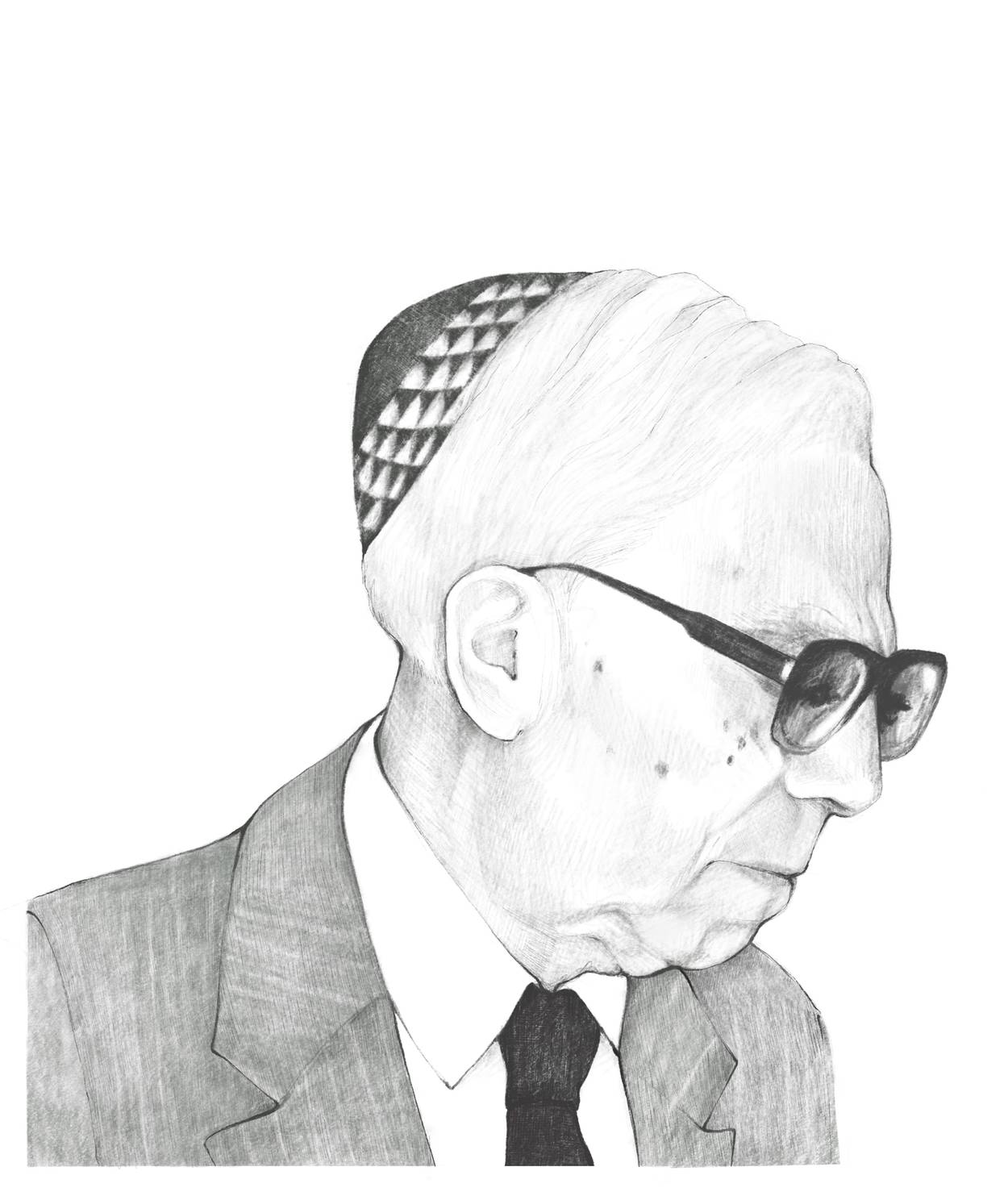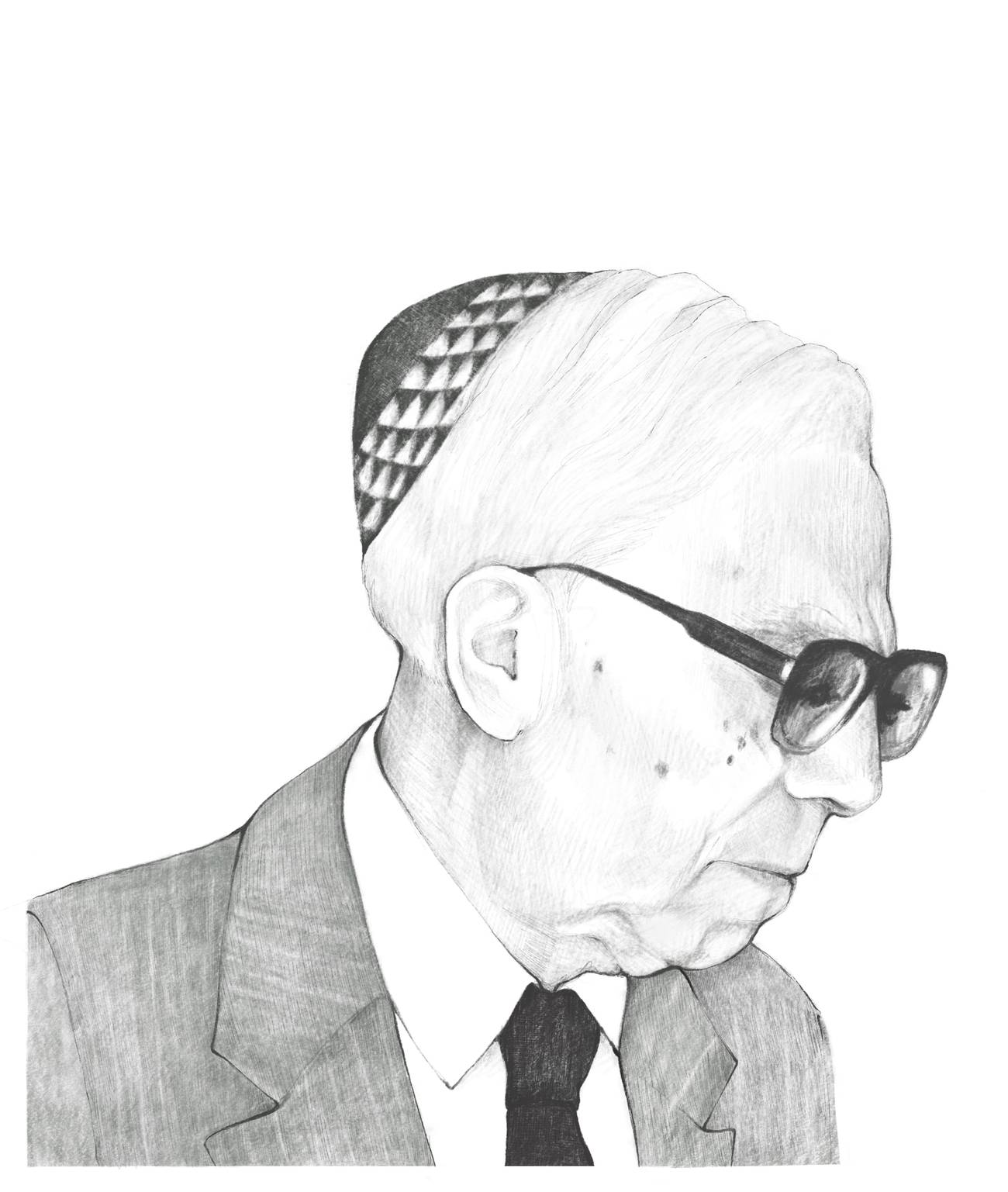Walking and Learning on Shabbos with Prof. Haim Zalman Dimitrovsky
A tribute to one of the great Talmudists, and teachers, of the 20th century




My mother’s father was religious; he was a yeshiva bokher and had been a kind of iluyi in Telz. He was the stepson of a rosh yeshiva. The lineage went something like this: My great-grandmother was widowed, and I am not sure whether her husband died before my grandfather was born or soon after, but the rosh yeshiva of Telz had lost his wife, maybe in giving birth to the eventual great Rabbi Elimeir Bloch זצ"ל. They got married very soon after: The only home that my grandfather knew was the home of the rosh yeshiva, the Mahari”l Bloch זצ"ל. He referred to him as “my father” and to Elimeir as “my brother.”
My grandfather was being groomed to be a rosh yeshiva, but he did not want that kind of life: That was just too much constraint, too much responsibility. One of the reasons that he left for the United States was to escape having to be the rosh yeshiva of Telz. At least that was the story told to me by my mother. What I can testify to directly is that the day after he retired from business, he went and sat in a yeshiva in the Bronx near where he had lived for a half century, and he went there every day, all day, until he couldn’t go any more, owing to advancing dementia.
My grandfather’s second wife, Frances, was my bubby from childhood; my biological grandmother died before I was born. My grandparents used to come to visit our farm in New Jersey once a month for the weekend, and every time they came, on Shabbos he would take me on a walk. He would tell me about the parsha of the week and about nature—he was in love with the seasons, the trees, the birds.
I think this love of nature was something that my grandfather brought with him from Lita. We think of the great yeshiva of Telz, and we imagine that it was some fantastic crenelated urban medieval structure like Jagiellonian University in Krakow. But this is not the case: Telz is a tiny little town, probably as big as Farmingdale, New Jersey. The building of the yeshiva, still standing, is about the size of a one-room schoolhouse, and five minutes from the yeshiva were woods and fields, where he remembered walking with his stepfather, the rosh yeshiva, on Shabbos.
That was really the first Torah I learned. Once, my grandfather told me, the rosh yeshiva (Rabbi Bloch זצ"ל) had said to him on one of those Shabbosim on seeing Gentile children playing, “What would it have hurt us to jump a little?” My love of lernen and my love of the world were conceived together and made powerful by those Shabbos walks in Farmingdale.
My great teacher: Harav Prof. Haim Zalman Dimitrovsky זצ"ל (my biological father was named Zalman also, but I think after the Alter Rebbe זצ"ל) also used to take me on lernen walks on Shabbos, and it is of him that I wish to write here today.
Prof. Dimitrovsky was a remarkable teacher and, of course, an incredible Talmid Khakham. As much as he taught us Talmud, he also taught us Derekh Eretz. He would not allow us to stand up when he entered the room, insisting that anything that produces distance (Distanz) between teacher and pupils is negative for teaching, as the students have to feel totally free to argue with the master. He took the Talmudic instruction that a strict master cannot teach to an extreme, and so we were not bayshanim (shy) to ask questions and challenge him. Once he said to us that the Ritva was a talmid of the Rashba, adding “that did not mean that he took a class with him.” And indeed, so he practiced as a teacher, and so I learned what it means to be a disciple.
We lived together in the same neighborhood for the years of my study, in Riverdale, and davened in the same shul, and we were frequently invited—that is, me, my wife, and our babies—to eat on Shabbos at the Dimitrovskys’ house. Our 18-month-old son (Prof. Shamma Boyarin) used to call him “Shabbos” (I think because he so often heard us saying “gut Shabbos.”). Prof. Dimitrovsky, in turn, called our two toddlers “This World” and “The Next World.” “This World” is today a lawyer and “The Next World” a professor of Jewish Studies.
For my doctoral exam, I had to master 300 pages of the Talmud, so I would learn about 10 daf a week. On Shabbos afternoon, between minchah and maariv, Professor Dimitrovsky would go for a walk with me and test me on the pages. I had just prepared the pages, whereas he had not, and yet he could, of course, and would, ask me very detailed questions. At the end of the walk, he would either tell me I could go on and learn the next pages or tell me to study the 10 pages again and come back next week.
In addition to the 300 pages, he also wanted me to learn several whole mesechtas or sections of the Talmud. Kesubos was one of the mesechtas that he insisted I learn, because as the proverb goes: “Kesubos holds the shlisslokh,” the keys to the entire Talmud. It is sometimes called “Shas Katan” (“the little Talmud”) because it includes virtually all of the halakhic themes that the Talmud explores. He used to say, “In order to be a Talmid khakham, you have to know three massekhtas really well”—Kesubos was one of them, along with Baba Metzia, but now, after nearly 60 years, I can’t remember the third. He said, “If you know those three massekhtas”—and when he said know, he meant know, which included Rashi, the tosafot, all the rishonim, and selected aharonim—“then you will be a talmid khakham.” I never learned the third massekhet.
Prof. Dimitrovsky’s own method of learning was different from many others. Rather than the various extant approaches that compared different portions from the Talmud with each other, resolving discrepancies between them, Prof. Dimitrovsky learned intensely on the page, closely following the logic of the argument. He questioned why one argument came before another; why what seemed redundant, wasn’t; why and how the sugya contradicted itself internally sometimes; why different styles of language were used; and the like. In contrast to other teachers and scholars, he was not interested in dissecting the Talmud but in interpreting the finished text in the sharpest and most convincing way possible. Once, I remember, I offered a new interpretation to an extremely difficult passage, to which came the gentle answer, “We have many clever and unconvincing interpretations of this passage already; what we need now is a convincing one.”
It was only later that I understood what he meant, having learned (from him) about the traditions of close and intense local analysis of the sugya that came down to us from two major learning legacies of the 15th and 16th centuries in two sites, the Sefardic site in Tsefat and related communities after the Expulsion, especially in the yeshiva of Rabbi Yaakov Berab and the Ashkenazi site of the Czech and Polish lands, of Prague, Krakow, and Poznan, of Rabbi Shalom Shakna, the Tzelakh, as well as others. He also taught us of the ultimate decay of those traditions and methods. One entire year of study was devoted to the history of methodology of Talmudic interpretation from Rashi in the 11th century to Brisk in the 19th and 20th centuries. One of the most important lines of the professor’s many lines of research was the detailed recovery of these methods of learning, collectively known as pilpul (not what was later misnamed pilpul), which also fed into his own learning and teaching. Of Prof. Dimitrovsky’s work in publishing Rishonim (medieval Talmudic commentaries), Prof. Lieberman would say, “If there is an edition of a Rishon edited by Dimitrovsky, you need no other commentaries on that massekhet; it’s all there in the notes!”
To finish this memoir/tribute to one of the great Talmudists of the 20th century and one of the finest teachers I’ve ever known, I’ll discuss a lecture—“Is There a Jewish Middle Ages?”—that he gave in Hebrew and only published in Hebrew on the way that the Talmud (Babylonian of course) became canonical—became, that is, what it has been for Jews since the 11th century.
Babylonia had been the homeland for a diaspora—figured most dramatically in the alleged dependence of the “Holy Land” on the Babylonian Sages—but is no longer. The new diaspora needs no center, since the Talmud in writing and its interpreting sages have been planted in the new diaspora from southern Italy. The Babylonian Talmud constitutes the communities of the West as their own diaspora. The traveling and shared book have become the homeland for these Jewish communities and ultimately for all Israel.
As my teacher, to whose memory this essay is dedicated, has lyrically written, “The period from the beginning of the 11th century and until the time when the world of Talmud ceased to be the world of the Jewish people … in its content, its spirit, and its tendencies, is a period in which the Talmud is the center of the world of the Jew.” A diaspora constituted by a book and its culture, not a lost homeland. As he wrote explicitly, “It has not yet been sufficiently proven that the preservation of the national character of the Jews outside their land is connected with the Land of the Jews. On the contrary; in the ancient sources, there appear clear echoes of a strong feeling of intellectual and religious nondependence and independence which was dominant among the Babylonian Jews.”
Perhaps the most lyrical statement of this love for the Talmud and for the culture it produced can be found in a final quotation from that essay: “From the 11th century on the Jewry of the world was not only under the regime of the Talmudic halakha but in the realm of the Talmudic culture. The Talmud became the book of the whole People and its songs, its daily conversation, and its discourse. Even more than the Bible, it was the Talmud that was the unifying and uniting force of the diasporas of Israel.” יהי זכרו ברוך
Daniel Boyarin is the Caroline Zelaznik Gruss and Joseph S. Gruss Visiting Professor in Talmudic Civil Law at Harvard Law School.